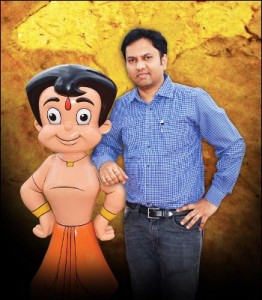 One would have been living in total isolation for the past seven years if he/she hasn’t taken notice of an Indian phenomenon called Chhota Bheem – an animation show created by Rajiv Chilaka of Green Gold Animation for children’s television channel Pogo – that has taken the children’s entertainment industry by storm.
One would have been living in total isolation for the past seven years if he/she hasn’t taken notice of an Indian phenomenon called Chhota Bheem – an animation show created by Rajiv Chilaka of Green Gold Animation for children’s television channel Pogo – that has taken the children’s entertainment industry by storm.
Green Gold Animation has been involved in producing original (Indian) IP animated content and has produced shows such as Vikram aur Betal and Krishna before working on Chhota Bheem. The company’s earlier shows helped it understand Indian kids better and based on those inputs, it managed to come up with the poster boy of Indian animation industry – Chhota Bheem.
Chhota Bheem continues to be rated as the number one children’s show from India. Nearly 200 episodes have been aired so far and more will follow in the months to come. As the show gained popularity, Green Gold began rolling out L & M activity and initially published comics and home videos as well. It identified key distributors/partners in various regions and started distributing its merchandise across India.
Establishing a children’s TV show as a trusted L & M brand was difficult. Prior to Chhota Bheem, there was limited or no content produced in India which was capable of competing with the top rated shows from across the world. Moreover, kids found Chhota Bheem a character they could connect with and relate to easily.
Green Gold began Green Gold Stores in an attempt to offer a good quality product at competitive and affordable rates. This has helped the company draw a positive response from the market and it has been able to extend the merchandise activity to various other product categories such as apparel, stationary and so on.
Chhota Bheem is now established as a brand and is receiving immense support from the TV channel (Pogo) as it has been showcasing it extensively, because of its huge popularity among children.
Chhota Bheem has helped Green Gold in exploring the L&M domain extensively and enabled the company to exploit similar avenues for other content properties such as Krishna, Krishna Balram and Vikram aur Betal. It has been able to establish and operate a solid product manufacturing and distribution pipeline across India.
After all these years of winning hearts and accolades, one might argue would Chhota Bheem as a brand – valued at nothing less a few hundred crore – be faced with the ‘Seven Year Itch’ as it celebrates its seventh birthday today.
In this special report we take a look at seven decisive aspects of the character, which have led to its sustained growth over the last seven years of its existence. Read on…
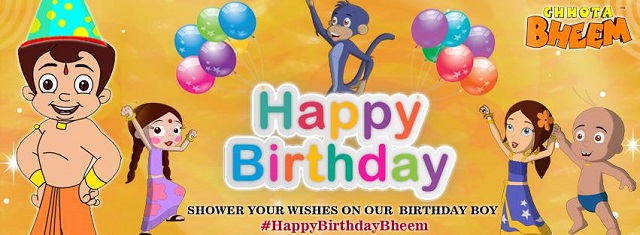 Character Design
Character Design
The character of Bheem (also the main protagonist) is an adventurous and fun-loving 9-year-old boy who is gifted with extraordinary strength (his character is a spin-off on the adult version of Bheem from the epic Mahabharat).
This power is a boon for Dholakpur, Bheem’s village, which is constantly beset by all kinds of perils. Bheem has a big heart and he always uses his strength to help those who are wronged or needy and nabs culprits, robbers and is seen as a guardian of the innocent and poor people and also the animals. He is the protector of the world. He loves food and has a certain craving for laddoos, which in fact, gives him a surge of energy and makes him even stronger than he normally is.
This fictional character, the brainchild of Rajiv Chilaka, is loved by children between ages 6 and 12, as they can very much relate to his simple boy-next-door look and feel. He’s often seen bare bodied in an orange dhoti and sports a small pony-tail. Since the character is always seen smiling and composed children have taken a liking to him and parents too feel safe in letting their offspring watch the series for hours.
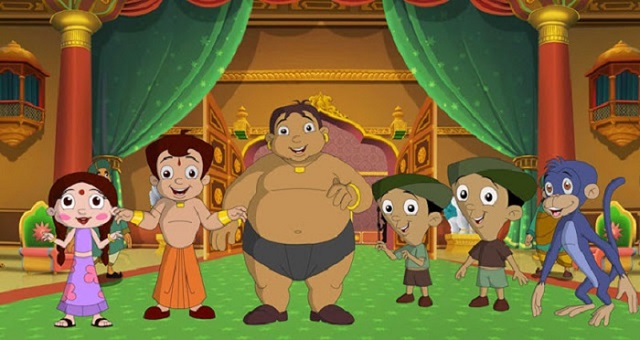 Costumes, Sets and Characters
Costumes, Sets and Characters
The entire show is created in 2D Animation using a Flash pipeline, thus giving the entire look a very seamless flow and design. The costumes, characters and sets are very neatly created and have their own distinctive qualities which go onto enhance the viewing experience of the kiddie audience.
Some bloggers have also taken offense to what they say are regressive traits in ‘Chhota Bheem‘. For instance, Chutki, one of Bheem‘s admirers, is described on the show’s website as ‘simple, graceful and intelligent…loves playing with the boys but is also feminine and involves herself with art and household chores’. She is seldom seen as a dominant person and this is not something that working mothers, for instance, may find very appealing.
The show’s bullies – Kalia, based on the evil Duryodhan, and his cronies, Dholu and Bholu – are distinctly darker in shade than any of the show’s more positive characters. Thus, the makers are also shedding light on the fact that the world is filled with both good and evil and its one’s choice of which side he/she would like to be on.
The backgrounds (BGs) showcase some great scenic beauty of India, which not only resonates with the domestic audience but also encourages a global audience to sit up and take notice of the diversity in the Indian geography.
The colourful costumes, justifying the various characters on the show is also something worth commending. A kid between the ages 6-12 years will always prefer to watch vibrant colours over dull or something with lesser colours, thus the makers have learnt from their earlier television outings and acclimatised to the tastes and viewing habits of their audience; which in turn has contributed in gaining further popularity among its target audience.
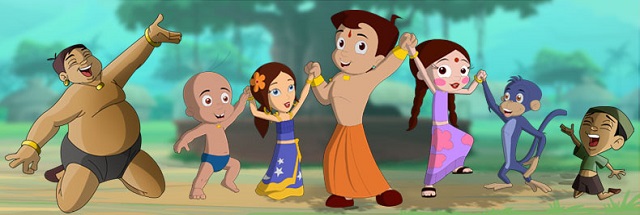 Storyline and Moral Values
Storyline and Moral Values
This children’s animation series is about an adventurous and fun-loving team of a 9-year-old boy Chhota Bheem in the mythical city of Dholakpur, which is consistently overwhelmed by all kinds of perils, and frequently attacked by robbers, thieves, and trickers.
Bheem plays the role of a mighty saviour of Dholakpur, who strives to restore the peace and prosperity. He is a legendary character comprising of intelligence, kindness, gentleness, friendliness, courage, strength and bravery.
Other characters in the team of Bheem – Raju, Jaggu are adorable; Chutki is witty and gentle towards all creatures; and Kalia, Dholu-Bholu are humorous. Altogether, they are unstoppable, as they fight against evils, demons and muggers, Kirmada, Kichak & Mangal Singh, Damyaan and his tribe and many others.
They travel together to liberate cursed, captured kingdoms from the clutches of evils, free the distressed people, redeem victims from curse, bravely tackle the obstacles and return in their own place by winning over witches and wizards.
If there are a few lessons that one can learn from this brilliantly crafted animated character and series, they would be: honesty, wit and boldness; never be jealous; stay united; be content; be considerate, generous and courteous; always stay calm and composed; be alert; have a sportsman spirit and have a sense of humour, among many others.
Children always look for an escape route from the pressures of school, peers and other troubles and Chhota Bheem comes to their rescue with his adventures and fantasy tales. Children can relate to him and wish to be part of his gang as he takes on baddies to save the day for his friends and his village. The makers clearly understand the psyche of today’s young minds and have successfully transcended those learnings into their fictional series.
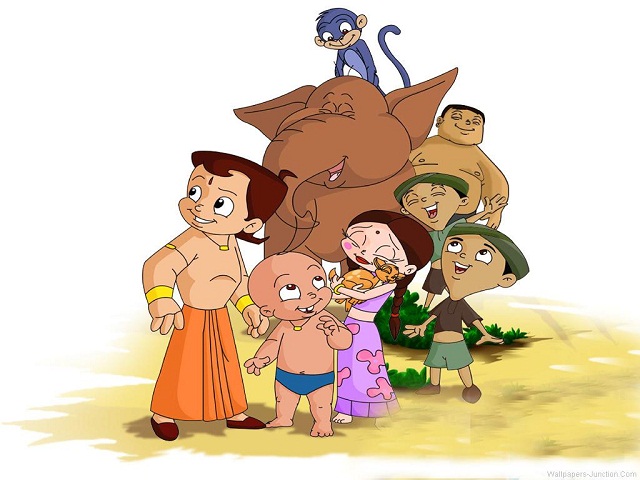 Association With Pogo
Association With Pogo
Children’s shows still command a meagre 2.5 per cent of advertising revenue despite a 7 per cent share of all the kids channels put together. The pie, though, has grown, from three channels some 15 years ago to 17 today, with six to seven of the dominant ones from bigger networks attracting 90 per cent of the eyeballs.
While most channels during the time were milking great revenues coming in by showcasing mostly iconic ‘foreign imports’, Turner’s bold move to experiment with a local IP didn’t just win them some great viewership numbers, but also the respect of the Indian animation community.
The channel was supportive of Chhota Bheem right from the preliminary stages when it was still trying to breach the barrier of being ‘Indian’ and yet being loved. The confidence that it showed over half a decade ago has paid rich dividends to the extent of even enjoying better viewership numbers than far older players in the kiddie space.
Theatrical Outings
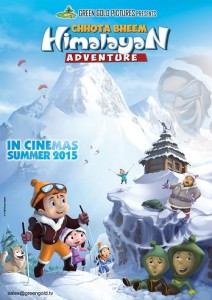 In an effort to live up to their promise of delivering a feature film every year since debuting in 2012 with Chhota Bheem, which was made at a budget of Rs 4 crore but recovered only Rs 3.3 crore; the team at Green Gold Animation, led by Rajiv Chilaka followed it up with the second feature Chhota Bheem and The Throne of Bali (2013) raking in only Rs 4.3 crore from its nearly Rs 8 crore investment.
In an effort to live up to their promise of delivering a feature film every year since debuting in 2012 with Chhota Bheem, which was made at a budget of Rs 4 crore but recovered only Rs 3.3 crore; the team at Green Gold Animation, led by Rajiv Chilaka followed it up with the second feature Chhota Bheem and The Throne of Bali (2013) raking in only Rs 4.3 crore from its nearly Rs 8 crore investment.
2014 saw Mighty Raju: Rio Calling, a 96 minute 2D flick made with a production budget of Rs 4 crore was targeted at the two to nine year age group. It was released across 300 multiplex screens in India on 16 May 2014, followed by releases in West Asia, UK, US and Southeast Asia in a phased manner.
Continuing its popular streak, Green Gold Pictures has announced its upcoming animation film in the Chhota Bheem series, titled The Himalayan Adventure of Chhota Bheem, which is slated to release in the latter half of 2015. This will be its fourth animation feature length film in the last three years.
Chhota Bheem will be seen in a new avatar, as he dons an ice jacket and treads through the snowy path to outwit his opponents with his gang of four. This time around the budget for this 90 odd minute 2D animation feature is hovering between Rs 5-6 crore and the team is also experimenting with using 3D backgrounds blended with the flash animation for the characters.
Green Gold Animation is consistently pushing the envelope for animation feature films in India and slowly but steadily also improving the quality of the animation that is being served to Indian audiences that is now more open to consuming good animation if it is produced well, and last year’s runaway success Chaar Sahibzaade is testament to that fact.
Merchandising and Brand Associations
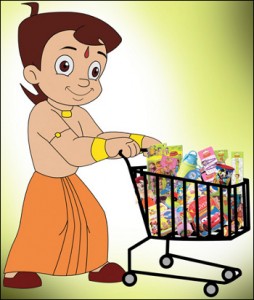 The merchandising business has taken off brilliantly and is growing at a steady 20 per cent annually for Green Gold, mostly on the success of brand Chhota Bheem. There are nearly 50 physical Green Gold stores – mostly filled with Chhota Bheem products – in Mumbai, Bangalore, Hyderabad and Delhi. Other characters are Mighty Raju, Krishna Balram, Luv Kush and Chorr Police. Of these stores, two are owned by Green Gold and the rest are franchisees. The company has a separate merchandising department with about 20 employees as well.
The merchandising business has taken off brilliantly and is growing at a steady 20 per cent annually for Green Gold, mostly on the success of brand Chhota Bheem. There are nearly 50 physical Green Gold stores – mostly filled with Chhota Bheem products – in Mumbai, Bangalore, Hyderabad and Delhi. Other characters are Mighty Raju, Krishna Balram, Luv Kush and Chorr Police. Of these stores, two are owned by Green Gold and the rest are franchisees. The company has a separate merchandising department with about 20 employees as well.
Apart from its own stores, one can find Chhots Bheem products across various e-commerce sites and also the character has tied-up with numerous brands across the media spectrum. To list a few names having associated with Chhota Bheem include: Amazon, Flipkart, Jabong, Snapdeal, Lenskart, Honda, Shopclues, Junglee, Fab Furnish, Naaptol, Kelloggs, Woodstock, Usha Fans, McDonald’s, Shemrock, among many others.
Marketing to children in any product category is frustratingly difficult. Their tastes are fickle; they can’t easily articulate why they like or don’t like something; their spending behaviours are controlled by somebody else – and they quickly grow out of the target segment.
Labour of Love
Chilaka has come a long way considering he had no connection to either the film or the television industry. After heading to the US for his Masters in Engineering at the University of Missouri, he realised he wanted to do something else. He had an inclination towards storytelling but felt his strengths were a mix of technology and creativity. So, he came to the conclusion that animation is where he can succeed. The goal to learn animation became an obsession and Chilaka eventually quit his job to end up at the animation school at San Francisco’s Academy of Arts, working into the wee hours in his pursuit of excellence.
 One day, struggling with conceptualising a more lucrative series after a not so ‘profitable’ deal for Vikram aur Betaal with Cartoon Network, Chilaka chanced upon his favourite character in the Mahabharata, Bheem, and thought of creating a younger version of him. But a pilot along with six developed episodes failed to get Turner’s Cartoon Network and the Disney network’s nod.
One day, struggling with conceptualising a more lucrative series after a not so ‘profitable’ deal for Vikram aur Betaal with Cartoon Network, Chilaka chanced upon his favourite character in the Mahabharata, Bheem, and thought of creating a younger version of him. But a pilot along with six developed episodes failed to get Turner’s Cartoon Network and the Disney network’s nod.
He then decided to re-work the look and feel of Chhota Bheem – after some success with his other ventures with Turner in the meanwhile – and re-pitched it to Turner. It got picked up as part of Turner’s Desi Toons (indigenous cartoons) series to localise more content. Which eventually went to Pogo. In three years, it became the top-rated kids show in India and still continues great viewership.
Chilaka exults that he sometimes can’t believe “that the character has grown so big!” None of the other creations from the studio has even come anywhere close to its star property. But, then, a Chhota Bheem too comes along once in a lifetime.

